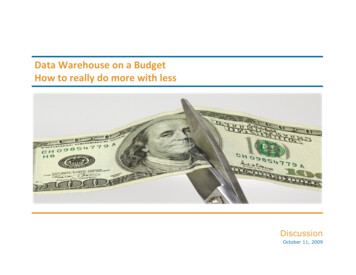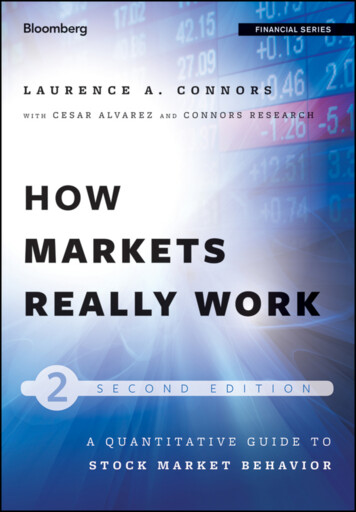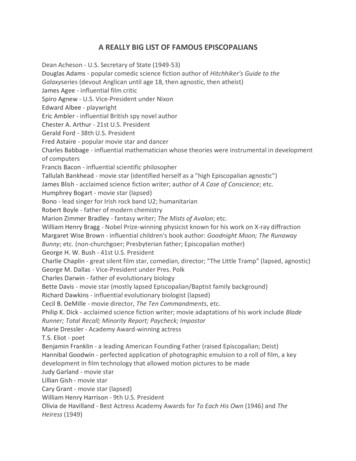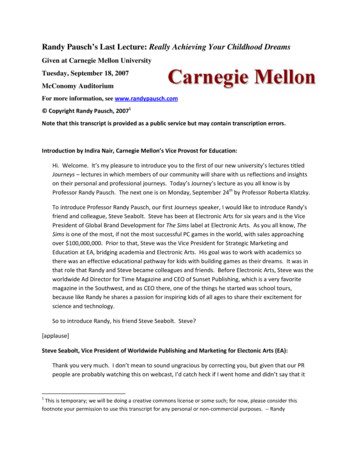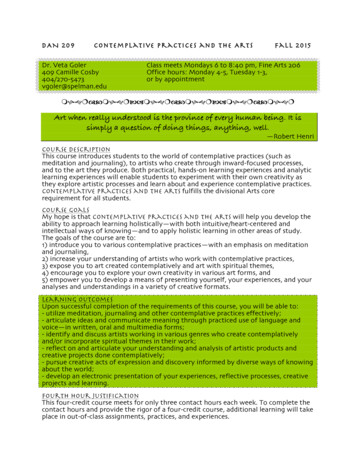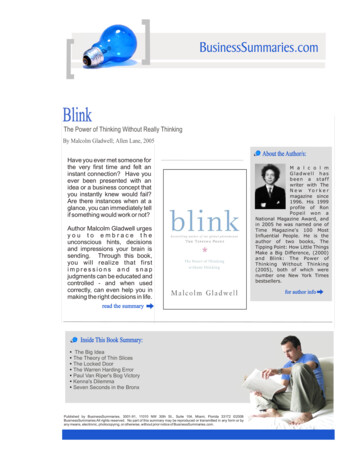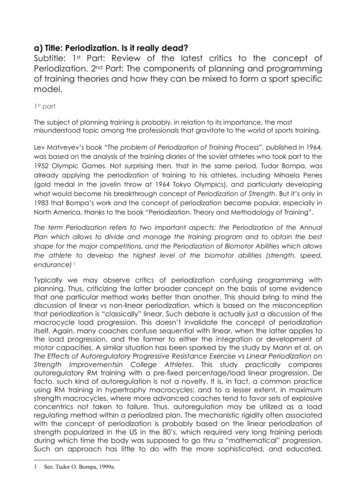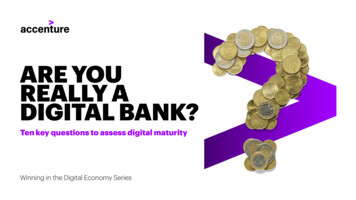
Transcription
ARE YOUREALLY ADIGITAL BANK?Ten key questions to assess digital maturityWinning in the Digital Economy Series
THE WORLD’SLEADING DIGITALRETAIL ANDCOMMERCIALBANKS HAVEMANY THINGSIN COMMON.They don’t do them all equally well, and commitment to each aspect varies frombank to bank, depending on their starting point, level of ambition and businessportfolio (lines of business and geographies in which they operate). Nevertheless,we see patterns emerging that we think allow for an objective assessment ofwhether a bank is making serious progress on its journey towards becoming atruly digital bank. We know from our recent industry research that masteringdigital is increasingly associated with both superior operating economics and amarket valuation premium, so having the right scorecard to assess digital maturityis important to a bank’s Board, C-suite and external stakeholders.Carl Jung, the father of analytical psychology, observed that ”to ask the rightquestion is already half the solution of a problem.” When we aggregated theexperience of the Accenture Banking practice we came up with ten questions,the answers to which serve as a good yardstick on whether a specific bankshould be considered in the digital premier league of the industry.ALAN MCINTYRESenior Managing Director—BankingAccenture2 TEN KEY QUESTIONS TO ASSESS DIGITAL MATURITY
01Does the bank have a mobile-firstdistribution model?02Is the bank eradicating back-office manualwork through intelligent operations?03Is the bank embracing Open Banking?04Is the bank willing to push the boundariesof its business model?05Has the bank become a truly data-drivenorganization?06Has the bank committed to public cloud asits default infrastructure?07Does the bank understand that trueenterprise agility is a team sport?08Does the bank’s business strategy emphasizeinnovation in the core?09Does the bank have a disciplined fintechengagement model?10Does the bank have a culture and HRapproach that values technology andengineering skills?3 TEN KEY QUESTIONS TO ASSESS DIGITAL MATURITY01Does the bank have a mobile-firstdistribution model?Regardless of the bank’s other channels for customer interaction (including branches,ATMs, call centers and relationship managers), does its customer engagement strategystart from the mobile experience and then considers how other channels can supportreimagined customer journeys. When you design for mobile first, other ways of interactingmove from being costly alternatives to differentiating enhancements, and that necessitatesthat non-mobile channels are staffed from top to bottom with people who understand andembrace the mobile-first approach, rather than resist it because they’re worried about theirjobs. It also typically means that all channels (physical and digital) should report up to thesame customer experience leader, rather than being siloed and potentially competing. In amobile-first world, traditional regional leaders whose power tends to reside in their feudaloversight of a specific geography or piece of the network can feel threatened, but thosepower hierarchies often don’t mesh well with a mobile-first approach. Mobile first doesn’tnecessarily mean a reduction in physical locations, but it does mean a change in the rolethey play in the distribution mix. With pure-digital challenger banks signing up millions ofcustomers, an outstanding mobile experience will be a prerequisite of future success forincumbent retail and commercial banks, but the best-performing ones will also change theterms of competition by using other channels to make their app experiences even better.
02Is the bank eradicating back-officemanual work through intelligentoperations?From risk management to customer service, the default processes should be data- andanalytics-powered and use all available RPA and AI tools to minimize human touchpoints,drive down the cost-to-serve, improve service levels and cross-sell ratios and enable theservicing of tens of thousands of retail and small business customers per employee. Wherehumans are still required to intervene, it should be to deploy judgment that is beyond thecapabilities of automated processes, with that portion of work shrinking every single day.Where the minimally efficient scale of operations is beyond a single institution, the bankshould be using utilities, outsourcers and partners that can help to further lower cost-toserve. Like in the best digital-native businesses, customers of leading digital banks shouldbe confident that a self-serve approach to problem resolution will be the quickest and mosteffective alternative compared to dialing a phone or driving to a branch. In most cases, beinga leading digital bank should mean absolute headcount reductions in back- office operationsand the clarity of purpose to reinvest most of those savings in front-office differentiation,while also recognizing that a slick and engaging back office can be an excellent digitalmarketing channel in and of itself.4 TEN KEY QUESTIONS TO ASSESS DIGITAL MATURITY
03Is the bank embracingOpen Banking?Rather than treating Open Banking as an annoying compliance and regulatory issue, the bestdigital banks are embracing both the import and export versions of it and are thinking abouttheir technology and infrastructure approach with the mindset of a trader rather than aprotectionist. An Open-Banking mindset naturally leads to a “platform-as-a-service” approachto core product and service capabilities that allows a bank to support both internal and externalusers through microservices and APIs. The import side of Open Banking also means buildinga systems infrastructure that can consume third-party capabilities by connecting to externalAPIs. A trader approach also has no time for the “not made here” mentality towards productsand, hence, the best banks are moving towards offerings that are demonstrably best for thecustomer rather than the bank. In this world, import/export API calls become an importantoperational metric and any European bank that is still insisting on pushing its own retail FXservice rather than integrating TransferWise is probably still struggling to understand thetrue impact of Open Banking. As one industry commentator noted, banking is rapidly movingfrom a plate of spaghetti to a lasagna and the leading digital banks are working out whichlayers they want to play in and also who owns and operates the points of connection.5 TEN KEY QUESTIONS TO ASSESS DIGITAL MATURITY
04Is the bank willing to push theboundaries of its business model?Is the bank actively considering income streams beyond traditional banking where the bankbelieves its customer relationships give it a competitive advantage? Digital innovations willincreasingly compress traditional fee income streams like payment and overdraft charges,so banks need to be willing to use their data and their privileged position in the transactionflow to dip their wheel into other revenue streams and help customers with non-financialservices purchases. The best digital banks are differentiating themselves by repositioningin their customers’ lives and rethinking their value proposition to go beyond the digitalpresentation of traditional bank products and instead be a trusted day-to-day advisorwho can improve broader financial well-being. In many cases, this implies material selfcannibalization of short- term product revenue to secure long-term customer loyalty andvalue. It also means building extensive partnerships with non-financial-services productproviders to recognize that both payments and credit are likely to become more and moreembedded and invisible in the future and that if banks don’t capture the advisory highground, they could be consigned to commodity providers behind the curtain of someoneelse’s value proposition.6 TEN KEY QUESTIONS TO ASSESS DIGITAL MATURITY
05Has the bank becomea truly data-drivenorganization?Has the bank figured out how to get measurable value from AI at scale byseparating out data provisioning and management from insight generationand value-realization activities? Not everyone who owns a car needs to drilltheir own oil well, so the best digital banks are mastering data supply chainand data management as an enterprise capability, balancing centralized dataprovisioning with decentralized insight utilization to drive increased profitability.The leading digital banks increasingly have a Chief Data Officer with a broadremit and a seat at the top table to ensure that data permeates every aspectof the organization. Banks have a privileged position in the economy in thatthey act as the scorekeepers and facilitators for everyone else’s business.Rather than relying on browser data and probabilistic inferences, banks getto see crystallized intent via payments and money movements. If data is thenew oil, then banks have advantaged access to some of the richest fields.The best banks know not only where to drill but also how to refine and usethe fuel that those wells provide.7 TEN KEY QUESTIONS TO ASSESS DIGITAL MATURITY06Has the bank committed topublic cloud as its defaultinfrastructure?A default public cloud architecture drives a lot of positive behaviors aroundmodern engineering practices, technology development approaches, datamanagement and analytics, and is a clear indicator of a future-oriented mindsetthat puts the burden of proof on status quo rather than change. While scalabilityand application rationalization can still be important elements of the businesscase for public cloud migration, increasingly the most compelling elementof the equation is native access to the data management and analytical toolsprovided by public cloud providers. Even if public cloud isn’t currently theright answer for certain applications (and there are lots of situations whereit still isn’t), the best digital banks continually ask the question, “Why not?”.The best digital banks will also address regulator concerns about public cloudand make the case that it should be their default. The less mature may hidebehind those regulatory concerns as a reason to slow their pace of change,but we think they’ll regret it.
07Does the bank understand that trueenterprise agility is a team sport?The central challenge with building a digital-first culture isn’t just technology developmentand building a conveyor belt of minimal viable products. It’s also about integrating all theHR, compliance, risk, financial planning and control systems to support an iterative andnimble approach to the business. Those that do it right are aggressively moving budgetsfrom run-the-business to change-the-business initiatives through an integrated financialinvestment plan and governance processes that focus less on fiefdoms and more on enterpriseoutcomes and winning together. Unfortunately, there is still a lot of lip service being paidto enterprise agility at the C-suite level, leaving many CIO evangelists to wade throughthe mud of legacy approval and monitoring processes. The path of least resistance thenbecomes small peripheral projects that allow a declaration of success on enterprise agilitywithout materially changing how the business operates. In contrast, leaders embraceenterprise agility as something that necessitates change in every aspect of how the bankis run and, hence, treat it as a revolution rather than an evolution.8 TEN KEY QUESTIONS TO ASSESS DIGITAL MATURITY
08Does the bank’s business strategyemphasize innovation in the core?Some banks, unfortunately, are hoping that peripheral challenger initiatives will somedaygrow to a scale that they will absorb and transform the legacy bank. Yet, without challenging thetechnology approach, culture, and ambition level of the piece of the bank that houses thebulk of the balance sheet and customers, banks’ fintech and innovation initiatives—regardlessof how press worthy they are—are likely to remain just gnats on the elephant from a valuationperspective. While many challenger banks are attracting impressive multi-billion-dollarvaluations, their tiny balance sheets and income streams often depend on payment processingfees that are continually being compressed, leading to questions about their long-termeconomic model. A decade from now, the best digital banks will have a strong balancesheet, stable funding and excellent risk management, not just a frothy valuation based onvague future growth plans. For incumbents, that means harnessing the power and strengthsof the traditional banking business model to better serve all of their customers, not dismissingthose capabilities (and the customers they serve) as irrelevant and outdated. For the bestchallengers, it means maturing into institutions whose business model isn’t radically differentfrom those banks they are seeking to replace, but which is far better executed.9 TEN KEY QUESTIONS TO ASSESS DIGITAL MATURITY
09Does the bank have a disciplinedfintech engagement model?A true digital bank has clarity around the its buy/partner/copy criteria to ensure its customerofferings always remain relevant. An Open Banking trader mentality can create a flotilla ofsupertankers and speedboats that can move in formation, with the best ideas and capabilitiesgetting to the front line quickly, rather than being stuck in stage-gate and vendor-assessmentpurgatory. While it is great to have innovation labs, venture capital investment stakes andconsortium memberships, the real litmus test for a bank’s engagement with the fintechcommunity is whether it increases the metabolism of change for their customer-facingpropositions. The trials of some of the banks that seek to buy innovation by trying to purchaseand integrate fintechs also show that the gravitational pull of the traditional bank businessmodel often isn’t overcome by a single innovative acquisition, regardless of the strength ofits momentum. No bank is going to be the sole source of innovation, so how a bank engageswith the broader ecosystem to filter, prioritize and moneti
Ten key questions to assess digital maturity ARE YOU REALLY A DIGITAL BANK? Winning in the Digital Economy Series . When you design for mobile first, other ways of interacting move from being costly alternatives to differentiating enhancements, and that necessitates that non-mobile channels are staffed from top to bottom with people who understand and embrace the mobile-first approach .

